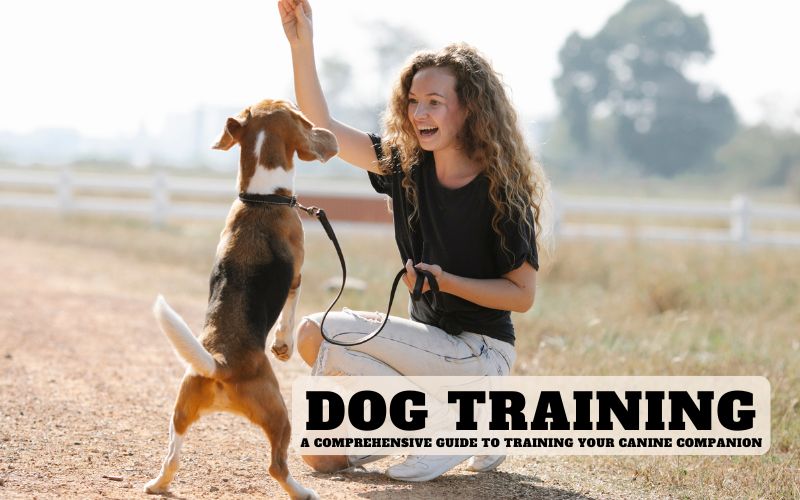Training your dog is one of the most rewarding experiences you can have as a pet owner. Not only does it enhance your bond with your furry friend, but it also ensures a well-behaved companion who can integrate seamlessly into your family and community. This article will provide a detailed, step-by-step guide to dog training, focusing on positive reinforcement techniques, effective communication, and the importance of patience and consistency.
Detailed Guide to Training Dogs Effectively at Home
Things to Prepare Before Starting Training
Before embarking on your dog training journey, it’s essential to prepare both yourself and your environment. Here are some key steps to ensure a successful training experience:
- Gather Training Supplies: Equip yourself with essential tools such as:
- Treats: Use small, soft treats that your dog loves. These will serve as rewards during training.
- Leash and Collar: A standard leash and a comfortable collar or harness are crucial for control during training sessions.
- Clicker (optional): A clicker can help mark desired behaviors instantly, making it easier for your dog to understand what you want.
- Choose a Training Space: Select a quiet, distraction-free area for training sessions. This could be your living room or backyard. Ensure the space is safe and free from hazards.
- Set a Training Schedule: Consistency is key in dog training. Plan short, frequent training sessions (5-10 minutes) throughout the day rather than long, exhausting sessions. This helps keep your dog engaged and prevents frustration.
Common Dog Training Methods
Understanding different training methods can help you choose the best approach for your dog. Here are the two primary methods:
- Positive Reinforcement: This method focuses on rewarding desired behaviors. When your dog performs a command correctly, immediately reward them with praise, treats, or playtime. This encourages them to repeat the behavior.
- Negative Reinforcement: This method involves removing an unpleasant stimulus when the desired behavior occurs. However, this approach can sometimes lead to fear or anxiety in dogs, so it’s generally recommended to focus on positive reinforcement.
Training Basic Commands: Sit, Lie Down, Stand, Come
Teaching basic commands is fundamental to effective dog training. Here’s how to train your dog to follow these commands:
- Sit:
- Hold a treat close to your dog’s nose.
- Move your hand up, allowing their head to follow the treat. This will cause their bottom to lower.
- Once in a sitting position, say “Sit,” and give them the treat.
- Repeat this several times until your dog consistently sits on command.
- Lie Down:
- Start with your dog in a sitting position.
- Hold a treat in your hand and move it to the ground, encouraging your dog to follow.
- As they lower their body to get the treat, say “Lie Down” and reward them.
- Practice this until they lie down reliably.
- Stand:
- Begin with your dog in a sitting position.
- Hold a treat in front of their nose and move it slightly forward.
- As they stand to reach for the treat, say “Stand” and reward them.
- Repeat until they stand on command.
- Come:
- Start in a controlled environment with your dog on a leash.
- Call your dog’s name followed by “Come” in a cheerful tone.
- Gently pull on the leash if they don’t respond, and reward them when they come to you.
- Gradually practice this in more distracting environments.
Addressing Common Issues During Dog Training
Training can sometimes reveal behavioral issues in dogs. Here are common problems and how to address them:
- Excessive Barking:
- Identify triggers (e.g., strangers, other dogs) and work on desensitizing your dog to these stimuli.
- Use commands like “Quiet” and reward them for being calm.
- Biting:
- If your dog nips during play, immediately stop the game and ignore them. This teaches them that biting leads to the end of fun.
- Provide appropriate chew toys to redirect their biting behavior.
- Fearfulness:
- Gradually expose your dog to the source of their fear in a controlled manner.
- Use treats and praise to create positive associations with the feared object or situation.
Choosing the Right Training Method for Each Dog Breed
Different dog breeds have unique characteristics that can influence their training. Understanding these traits can help you tailor your approach.
Training Characteristics of Common Dog Breeds
- Herding Dogs (e.g., Border Collies):
- Highly intelligent and energetic, these dogs thrive on mental stimulation.
- Incorporate agility and obedience training to keep them engaged.
- Hunting Dogs (e.g., Labrador Retrievers):
- These dogs are eager to please and respond well to positive reinforcement.
- Use fetch games to reinforce commands like “Come” and “Sit.”
- Small Dogs (e.g., Chihuahuas):
- Often more stubborn, small dogs may require extra patience.
- Focus on socialization and basic commands, rewarding them generously for good behavior.
Selecting Training Methods Based on Your Dog’s Personality
Understanding your dog’s personality is crucial for effective training. Consider the following:
- Shy or Anxious Dogs: Use gentle, encouraging methods. Avoid loud commands or harsh corrections, and focus on building their confidence through positive reinforcement.
- Outgoing and Energetic Dogs: Incorporate play into training sessions. Use high-energy games and rewards to keep them motivated.
The Importance of Patience and Consistency in Training
Training your dog requires both patience and consistency. Here’s why these qualities are essential:
- Building Trust: Dogs thrive on routine. Consistent commands and rewards help them understand what is expected, fostering trust between you and your dog.
- Avoiding Frustration: Training can be challenging. If you remain patient, you’ll be better equipped to handle setbacks and keep your dog motivated.
Building a Strong Relationship with Your Dog
A solid relationship with your dog enhances training effectiveness. Here are some strategies to strengthen your bond:
The Importance of Communicating with Your Dog
Effective communication is vital for successful training. Use clear, consistent commands and body language to convey your expectations. For example, maintain eye contact and use a cheerful tone to encourage your dog.
Dog Body Language and How to Understand It
Understanding your dog’s body language can improve your training sessions. Here are some signs to watch for:
- Relaxed Ears and Tail: Indicates a happy and comfortable dog.
- Raised Hackles: May signal fear or aggression; approach with caution.
- Play Bow: A sign that your dog wants to play, indicating a positive mood.
Creating a Positive Training Environment
A positive environment is crucial for effective training. Here are tips to create a supportive space:
- Minimize Distractions: Choose a quiet area for training sessions to help your dog focus.
- Use Positive Reinforcement: Always reward good behavior to encourage your dog to repeat it.
Rewarding and Motivating Your Dog
Rewards are a powerful motivator in dog training. Here’s how to effectively use them:
- Variety of Rewards: Use a mix of treats, toys, and praise to keep your dog excited about training.
- Timing is Key: Reward your dog immediately after they perform the desired behavior to reinforce the connection.
Effective Dog Training Tools
Using the right tools can enhance your training experience. Here’s a look at some essential tools:
Purpose and Usage of Leashes and Collars
- Leash: A standard leash helps maintain control during training. Choose a length that allows freedom of movement while keeping your dog safe.
- Collar or Harness: Select a comfortable collar or harness that fits well. Harnesses are often recommended for dogs that pull, as they distribute pressure more evenly.
Pros and Cons of Different Training Toys
Training toys can make sessions more engaging. Here’s a quick overview:
| Toy Type | Pros | Cons |
|---|---|---|
| Treat Dispensing | Keeps dogs engaged; encourages problem-solving | May lead to overeating if not monitored |
| Tug Toys | Great for interactive play; builds trust | Can encourage aggressive behavior if not controlled |
| Fetch Toys | Encourages exercise; reinforces recall | Requires space and supervision |
Applying Technology in Dog Training
Modern technology can enhance dog training. Here are some tools to consider:
- Training Apps: Many apps offer training tips, tracking progress, and reminders for training sessions.
- Smart Devices: Interactive cameras or treat dispensers can help you train your dog remotely, allowing for reinforcement even when you’re not home.
Seeking Help from Professional Dog Trainers
While many dog owners successfully train their pets at home, sometimes professional help is beneficial. Here’s when and how to seek assistance:
When to Seek Professional Help
Consider professional training if:
- Your dog exhibits severe behavioral issues (e.g., aggression, extreme anxiety).
- You feel overwhelmed or unsure about how to proceed with training.
How to Choose a Reputable Dog Trainer
Selecting the right trainer is crucial. Here are tips to find a reputable professional:
- Check Credentials: Look for trainers with certifications from recognized organizations.
- Read Reviews: Seek testimonials from other dog owners to gauge the trainer’s effectiveness.
Questions to Ask When Choosing a Trainer
When interviewing potential trainers, consider asking:
- What training methods do you use?
- How do you handle behavioral issues?
- Can you provide references from previous clients?
Conclusion
Training your dog is a journey that requires dedication, patience, and love. By following the steps outlined in this guide, you can foster a strong bond with your canine companion while instilling good behavior. Remember, the key to successful dog training lies in positive reinforcement, clear communication, and consistency.
FAQ
- How long does it take to train a dog?
- Training duration varies by dog and command complexity. Basic commands may take a few weeks with regular practice.
- What is the best age to start training a puppy?
- Start training as early as 8 weeks old. Early socialization is crucial for developing a well-adjusted dog.
- Can older dogs be trained?
- Yes! Older dogs can learn new commands and behaviors, though they may require more patience.
- What should I do if my dog doesn’t respond to commands?
- Ensure you’re using positive reinforcement and check for distractions. If issues persist, consider consulting a professional trainer.
- How often should I train my dog?
- Aim for short, frequent training sessions (5-10 minutes) several times a day to maintain engagement and reinforce learning.
Key Takeaways
- Training your dog enhances your bond and ensures good behavior.
- Use positive reinforcement techniques for effective training.
- Understand your dog’s breed and personality for tailored training.
- Create a positive training environment and use appropriate tools.
- Seek professional help if needed for behavioral issues.
By following these guidelines, you can embark on a fulfilling journey of dog training that leads to a harmonious relationship with your furry friend.


